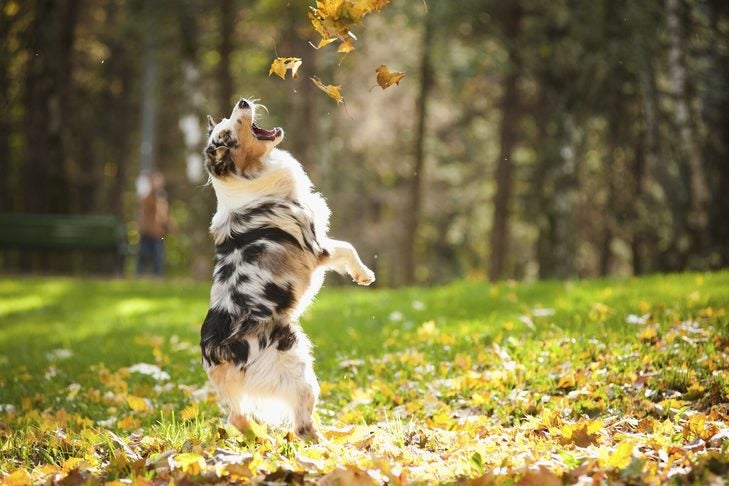
AKC is a participant in affiliate advertising programs designed to provide a means for sites to earn advertising fees by advertising and linking to akc.org. If you purchase a product through this article, we may receive a portion of the sale.
The temperature is dropping, trees are covered in shades of orange, and leaves coat the sidewalk. Fall is in the air.
While you may enjoy the sound of crunching leaves under your feet, you may not find it so lovely when your dog is munching on a stray leaf or two. Eating certain types of leaves (or eating leaves all the time) can be dangerous for your dog.
Why Do Dogs Even Eat Leaves?
So why do pups want to eat leaves in the first place? Research shows that eating leaves isn’t just domesticated dog behavior. For example, wolves have been observed eating grass and leaves in the wild, especially when they aren’t able to find regular sources of meat. While plants are not as nutritionally dense as meat, wild dogs or wolves may still use them to fill gaps in their diet.

While leaves may be high in fiber, they are not nutritious. So they will not enrich your dog’s diet in any meaningful way. If your pup seems to love the taste or texture of leaves, consider adding dog-friendly herbs and vegetables into their diet, such as carrots, peas, and celery. You could even plant a dog-friendly herb garden, which may include rosemary, basil, and thyme.
If your dog has an upset stomach, they may also use leaves and grass as a way to make themselves vomit and get rid of whatever is causing them gastrointestinal pain. Leaves and grass are not technically harmful, but, in large amounts, they can cause a blockage, especially in puppies. Make sure to keep an eye on how often your dog is vomiting, especially concerning how much foliage they’re consuming. It could be a sign of an underlying gastrointestinal issue, which could require a visit to your veterinarian.
Eating leaves while on a walk is also risky, as that foliage could be covered in pesticides or other harmful chemicals. While most leaves that fall from trees are harmless, there are also a few toxic trees and plants whose leaves, nuts, or berries can make your dog very ill, including black walnut trees, Japanese yews, and tomato plants. Make sure to familiarize yourself with the types of trees in your yard and neighborhood.
The interest in leaves may also be an indicator that your dog is bored and need something to keep their attention. Try purchasing chewing sticks to redirect their need to eat leaves. You can also try puzzle toys to stimulate your dog’s brain and get them to engage with something other than leaves.
How Can You Curb Leaf-Eating Behavior?
Your dog may think leaves are a special kind of canine potato chip, but it’s never fun to clean up vomit after they gorge themselves. If you’re concerned about the behavior, there are a few easy ways to keep your dog from eating too much fall foliage.
First, when you let your pup outside, follow them and keep a close watch on what they put in their mouths. If they start eating a leaf, give them a stern “no,” and gently remove the leaf. If they start to eat leaves while on a walk, give the leash a gentle tug, followed by “no,” and redirect their attention.

Lastly, make sure to make time to play with your dog. If you let them outside and they start to sniff for a backyard snack, throw a ball or other toy to redirect their attention.
Exercise and interaction with their owner may provide a distraction from the fall snack. It will help strengthen the bond you have with your dog.

